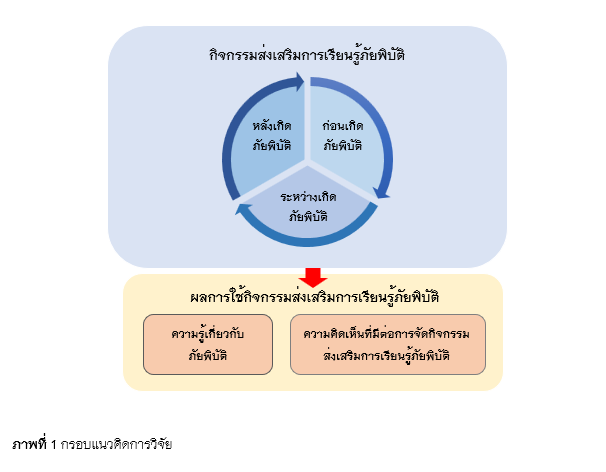Developing Activities to Enhance Disaster Learning for Kids and Youth, Chiang Rai
Main Article Content
Abstract
The research entitled "Developing Activities to Enhance Disaster Learning for Kids and Youth, Chiang Rai" aimed to develop and study the effects of using activities to enhance disaster learning for kids and youth in Chiang Rai province. The sample group and the target group consisted of; 1) 320 Social Studies teachers in Chiang Rai province, who provided basic background and needs information, 2) 15 experts on disaster and learning management, and 3) 160 primary students and 40 secondary students in Chiang Rai province, who participated in the disaster learning activities trial. The research instruments comprised a questionnaire on the need for organizing activities, a focus group record, the handbook of activities to enhance disaster learning, a feasibility evaluation form, a test, an observation form about the preparation for the disaster, and a questionnaire on opinions about participating as a youth leader of disaster in Chiang Rai province. The data were analyzed using frequency, percentage, mean, standard deviation, and content analysis.
The research findings were as follows; 1) The development of activities to enhance disaster learning for kids and youth in Chiang Rai province showed that: 1.1) The need for organizing disaster learning activities of the Social Science teachers was at a high level. When considering each item, it was found that the learning activity was at the highest level. The content should emphasize the disasters in Chiang Rai province and activities for readiness and survival from disaster should be practical and can be applied in daily life. 1.2) The five main activities to enhance disaster learning for kids and youth in Chiang Rai province were feasible at the highest level. 2.) The effects of using activities to enhance disaster learning for kids and youth in Chiang Rai province were as follows: 2.1) The average scores of primary and secondary students who participated in the activities to enhance disaster learning were higher after participation. The average score of primary students after learning was 17.07 (a very good level). The average score of secondary students after learning was 17.18 (a very good level). 2.2) The overall satisfaction of students who participated in the disaster learning activities was at a high level.
Downloads
Article Details

This work is licensed under a Creative Commons Attribution-NonCommercial-NoDerivatives 4.0 International License.
References
Akkarapongpaiboon, T., Chirinang, P., Raktham, A., & Fuangchan, S. (2020). Integrating disaster management in the 4.0 era. Journal of Administrative and Management Innovation, 8(3), 14-23. [in Thai]
Banchee, P. (2020). 'Chiang Rai' is flooded, Statement on dealing with 3 disasters. Retrieved from https://www.77kaoded.com/news/petay/1404209 [in Thai]
Federal Emergency Management Agency (FEMA). (2006). Principles of emergency management. Retrieved from http://www.rn.org/courses/coursematerial-80.pdf
Health and Education Department. (2010). Disaster and emergency preparedness: Activity guide for K to 6th grade teachers. Washington, DC: International Finance Cooperation. Retrieved from https://inee.org/sites/default/files/resources/IFC_Disaster_Emergency_Prep_Schools_Guide_ ENG.pdf?fbclid=IwAR0ZQN5j-L-SugAfwqAt0bDhoAQ5hdp7lH8tidZa0lfPj29rghVJPFD-pz4
Jantakoon, J. (2015). Disaster education: Learning approach to disaster preparedness activities (Part 1). Journal of Education Naresuan University, 16(4), 188-201. [in Thai]
Jantakoon, J. (2016). Disaster education: Learning approach to disaster preparedness activities (Part 2). Journal of Education Naresuan University, 18(3), 364-376. [in Thai]
Jantakoon, J., Klincharoen, K., & Wattanatorn, A. (2021). The Development of earthquake preparedness capacity of students by using activity – Based learning: A Case of Mae Lao Wittayakom School, Chiang Rai Province. Journal of Social Science and Buddhistic Anthropology, 6(12), 122-137. [in Thai]
Kosonkittiumporn, S., Loiwirat, T., Watthanakul, P., & Juansang, A. (2020). Disaster management approaches: From public sector to communities. Journal of MCU Peace Studies, 8(1), 348-360. [in Thai]
Krejcie, R. V., & Morgan, D. W. (1970). Determining sample size for research activities. Educational and Psychological Measurement, 30(3), 607–610.
Manager Online. (2021). Final flood! Rain hits Shan State-Water overflows over bridge edge border market Mae Sai-Tachileik sinks to the chest. Retrieved from https://mgronline.com/local/detail/9640000107962 [in Thai]
Masatienwong, C. (2012). Lessons from the great flood and new learning for children and youth. Bangkok: The Thailand Research Fund. [in Thai]
Office of the Basic Education Commission. (2012). Guidelines for disaster management in educational institutions and educational service area. Bangkok: Office of the Welfare Promotion Commission for Teachers and Educational Personnel Printing. [in Thai]
Panyaprouks, S. (2019). Stepping into new learning management in the 21st century. (2th ed.). Bangkok: Danex Intercorporation Company Limited. [in Thai]
Patphol, M. (2019). Designing innovative curriculum. Bangkok: Curriculum and Learning Innovation Leadership Center. [in Thai]
Pitakpakawiwat, N. (2021). The development of learning activities by using case - based learning that promote capacity to cope with disasters of Mathayom 1 students. (Master’s Independent Study, Naresuan University). [in Thai]
Provincial Community Development Office of Chiang Rai. (2021). Summary of the results of collecting basic necessity and basic level information, Village level, Chiang Rai province 2019. Retrieved from https://chiangrai.cdd.go.th/wp-content/uploads/sites/14/2019/07/0019.3-_%E0%B8%A717288.pdf [in Thai]
Saengloetuthai, J., Thongnin, P., Booncherdchoo, N., Maneerat, C., Srisopha, Y, & Takomsane, M. (2020). Action learning. Academic Journal of Phetchaburi Rajabhat University, 10(3), 155-163. [in Thai]
Sinthapanon, S. (2015). Learning management for modern teachers to develop students' skills in the 21st century. Bangkok: 9119 Technic Printing. [in Thai]
Thanachaikhan, N. (2009). Statistics for research. Chiang Rai: Faculty of Science and Technology, Chiang Rai Rajabhat University. [in Thai]
United Nations Children’s Fund (UNICEF). (2021). The climate crisis is a child rights crisis: Introducing the children’s climate risk index. Retrieved from http://www.unicef.org/thailand/media/7731/file/The%20climate%20crisis%20is%20a%20child%20rights%20crisis%20EN.pdf
Wannasri, J. (2020). Innovation for educational institution development. Phitsanulok: Rattanasuwan Printing 3. [in Thai]
Wongyai, W., & Patphol, M. (2020). Heart of learning. Bangkok: The Graduate School of Srinakharinwirot University. [in Thai]


